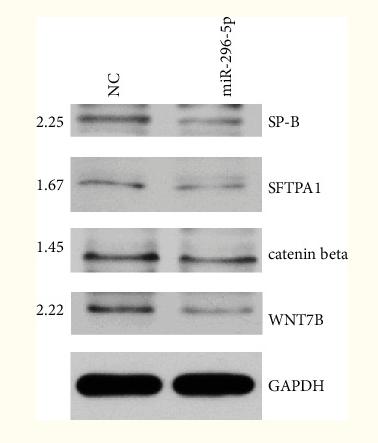SFTPA1 Antibody - #DF7204
| Product: | SFTPA1 Antibody |
| Catalog: | DF7204 |
| Description: | Rabbit polyclonal antibody to SFTPA1 |
| Application: | WB IHC |
| Reactivity: | Human, Mouse, Rat |
| Prediction: | Bovine, Horse, Sheep, Rabbit, Dog |
| Mol.Wt.: | 28kDa; 26kD(Calculated). |
| Uniprot: | Q8IWL2 |
| RRID: | AB_2839155 |
Related Downloads
Protocols
Product Info
*The optimal dilutions should be determined by the end user.
*Tips:
WB: For western blot detection of denatured protein samples. IHC: For immunohistochemical detection of paraffin sections (IHC-p) or frozen sections (IHC-f) of tissue samples. IF/ICC: For immunofluorescence detection of cell samples. ELISA(peptide): For ELISA detection of antigenic peptide.
Cite Format: Affinity Biosciences Cat# DF7204, RRID:AB_2839155.
Fold/Unfold
35 kDa pulmonary surfactant associated protein; 35 kDa pulmonary surfactant-associated protein; Alveolar proteinosis protein; COLEC4; Collectin 4; Collectin-4; FLJ50593; FLJ51913; FLJ61144; FLJ77898,; FLJ79095; FLJ99559; MGC133365; MGC198590; OTTHUMP00000019928; OTTHUMP00000019929; OTTHUMP00000019930; OTTHUMP00000019931; PSAP; PSP A; PSP-A; PSPA; pulmonary surfactant -associated protein, 35-KD; pulmonary surfactant apoprotein PSP-A; pulmonary surfactant associated protein A1; Pulmonary surfactant-associated protein A1; SFTA1_HUMAN; SFTP1; SFTPA1; SFTPA1B; SP A; SP A1; SP-A; SP-A1; SPA; SPA1; surfactant protein A1; surfactant protein A1 variant AB'D' 6A2; surfactant protein A1 variant AB'D' 6A3; surfactant protein A1 variant AB'D' 6A4; surfactant protein A1 variant ACD' 6A2; surfactant protein A1 variant ACD' 6A3; surfactant protein A1 variant ACD' 6A4; surfactant protein A1 variant AD' 6A; surfactant protein A1 variant AD' 6A2; surfactant protein A1 variant AD' 6A3; surfactant protein A1 variant AD' 6A4; surfactant protein A1B; surfactant, pulmonary associated protein A1A; surfactant, pulmonary associated protein A1B; surfactant-associated protein, pulmonary 1;
Immunogens
- Q8IWL2 SFTA1_HUMAN:
- Protein BLAST With
- NCBI/
- ExPASy/
- Uniprot
MWLCPLALNLILMAASGAVCEVKDVCVGSPGIPGTPGSHGLPGRDGRDGLKGDPGPPGPMGPPGEMPCPPGNDGLPGAPGIPGECGEKGEPGERGPPGLPAHLDEELQATLHDFRHQILQTRGALSLQGSIMTVGEKVFSSNGQSITFDAIQEACARAGGRIAVPRNPEENEAIASFVKKYNTYAYVGLTEGPSPGDFRYSDGTPVNYTNWYRGEPAGRGKEQCVEMYTDGQWNDRNCLYSRLTICEF
Predictions
Score>80(red) has high confidence and is suggested to be used for WB detection. *The prediction model is mainly based on the alignment of immunogen sequences, the results are for reference only, not as the basis of quality assurance.
High(score>80) Medium(80>score>50) Low(score<50) No confidence
PTMs - Q8IWL2 As Substrate
| Site | PTM Type | Enzyme | Source |
|---|---|---|---|
| Y184 | Phosphorylation | Uniprot | |
| S241 | Phosphorylation | Uniprot |
Research Backgrounds
In presence of calcium ions, it binds to surfactant phospholipids and contributes to lower the surface tension at the air-liquid interface in the alveoli of the mammalian lung and is essential for normal respiration. Enhances the expression of MYO18A/SP-R210 on alveolar macrophages (By similarity).
(Microbial infection) Recognition of M.tuberculosis by dendritic cells may occur partially via this molecule. Can recognize, bind, and opsonize pathogens to enhance their elimination by alveolar macrophages.
N-acetylated.
Secreted>Extracellular space>Extracellular matrix. Secreted>Extracellular space>Surface film.
Oligomeric complex of 6 set of homotrimers.
(Microbial infection) Binds M.bovis cell surface protein Apa via its glycosylated sites; probably also recognizes other bacterial moieties.
(Microbial infection) Binds to the S.aureus extracellular adherence protein, Eap, thereby enhancing phagocytosis and killing of S.aureus by alveolar macrophages.
Belongs to the SFTPA family.
Research Fields
· Cellular Processes > Transport and catabolism > Phagosome. (View pathway)
· Human Diseases > Infectious diseases: Bacterial > Pertussis.
References
Application: WB Species: Human Sample: A549 cell
Restrictive clause
Affinity Biosciences tests all products strictly. Citations are provided as a resource for additional applications that have not been validated by Affinity Biosciences. Please choose the appropriate format for each application and consult Materials and Methods sections for additional details about the use of any product in these publications.
For Research Use Only.
Not for use in diagnostic or therapeutic procedures. Not for resale. Not for distribution without written consent. Affinity Biosciences will not be held responsible for patent infringement or other violations that may occur with the use of our products. Affinity Biosciences, Affinity Biosciences Logo and all other trademarks are the property of Affinity Biosciences LTD.

